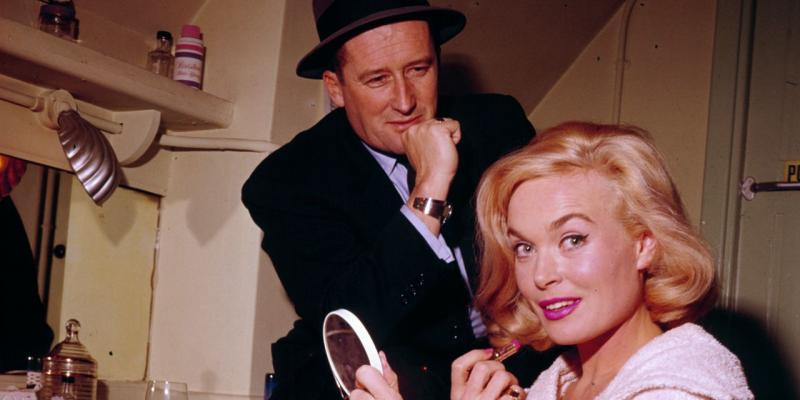'Spillane' Review: He Nailed Mike Hammer
By: Michael Saler (WSJ)



Mickey Spillane knew how to make crime pay, and he transformed the American publishing industry in the process. Between 1947 and 1952, his first six novels featuring private investigator Mike Hammer, a sadist with a heart of gold, sold millions of copies in paperback—bringing legitimacy to the fledgling format. Spillane's global sales now exceed 200 million.
His recipe for success appeared simple. Mix racy innuendo ("She was oozing out of a bikini suit like toothpaste out of a tube") with graphic violence ("I snapped the side of the rod across his jaw and laid the flesh open to the bone"); season with stereotypes and vivid prose; knead these raw materials into a propulsive plot pitting good versus evil. Et voila: "The chewing gum of American literature," as Spillane cheerfully admitted. Many critics of the time, repelled by his vigilantism and sensationalism, condemned his books as nasty, poor, brutish and not short enough. Others found that Hammer's sincere conviction exerted a powerful spell.
Noir fans know a lot about Mike Hammer, but who was Mickey Spillane? Max Allan Collins and James L. Traylor are Spillane experts who have championed the author’s works since the early 1980s. Mr. Collins, a noted crime writer, also collaborated with Spillane and has been completing drafts left by Spillane upon his death in 2006. The biographers concede their partisanship but avow they have been “hard-nosed” about their hard-boiled subject. “Spillane” is an engaging, capacious and largely celebratory account, presenting the writer, his works and their multimedia adaptations as worthy of serious consideration.
Spillane was born in 1918, the only child of a Catholic father and Protestant mother. Religion would play a significant role in his life: He became a Baptist, like his first wife Mary Ann, whom he married in 1945; in 1951 he converted to the Jehovah’s Witnesses. His biographers suggest that Hammer’s Old Testament, “eye-for-an-eye” justice is partly beholden to Spillane’s religious outlook. As a youth, however, Spillane may not have been devout; he loved adventure and crime fiction and claimed to have published short stories under pseudonyms soon after graduating high school. He left college after two years to join the nascent comic-book industry in New York City, honing his skills by scripting early adventures of Captain America and other crime fighters.
Spillane spent World War II stateside as a flight instructor. His biographers believe he suffered “survivor’s guilt,” which may have contributed to the macho postures he shared with Hammer. After the war he also came to loathe cities and their immoral, high-rise-residing “cliff-dwellers.” Needing money to build a house in the country, Spillane transformed an unsold comic story about “Mike Danger” into “I, the Jury” (1947), which introduced Mike Hammer as a traumatized combat veteran who relishes dispatching killers by employing their own methods. The book sold modestly in hardcover but proved a sensation in paperback, appealing especially to veterans accustomed to reading comics and “Armed Services” softcover editions during the war. Paperbacks had hitherto consisted of reprints; Spillane’s sales convinced publishers to issue original works—a sea change in the industry.
The authors find that the early Hammer novels portray a conflicted protagonist remaking his moral compass. In “One Lonely Night” (1951), Hammer searches for his own identity alongside that of the murderer. He concludes that God has fashioned him as a monster for the greater good: “I was the evil that opposed other evil, leaving the good and the meek . . . to live and inherit the earth!”
After reaching unprecedented popularity by 1952, Spillane ceased writing novels for a decade. Previous commentators assumed he was occupied with, and perhaps inhibited by, his new religion. But the authors suggest that his silence owed as much to his wealth and the distracting hobbies it permitted; he had also sold the film rights to his hero and was biding his time, waiting to reclaim them.
When Spillane returned to writing novels in 1962, with “The Girl Hunters,” his narratives were more polished but lacked the manic energy of earlier works. By this time, both Spillane and Hammer had become pop-culture touchstones. The author would portray Hammer in the 1963 film version of “The Girl Hunters,” and subsequently blurred the line between himself and his hero. Spillane divorced in 1962, marrying again in 1964. His second wife, Sherri, was half his age, a model who played the “doll” alongside Spillane’s public appearances as “the living embodiment” of Hammer. Spillane even assumed the Hammer persona for Miller Lite Beer commercials, a campaign that continued from the 1970s through the 1990s. The genial Spillane and the grim Hammer became coterminous in the public mind, leaching certain dark undercurrents from the fictional character.
“Spillane” emphasizes the gentler side of its subject, only fleetingly considering the charming writer’s crueller opinions and actions. Yet Mr. Collins does recall a frightening instance he witnessed in 1992. Spillane’s home had been burgled and the author, gesticulating with his fists, “told me vividly what he’d like to do to the thieves.” Then the squall subsided. “But I’m not like that anymore. I don’t do that now.”
The biography concludes on such grace notes. After an acrimonious divorce from Sherri, Spillane married for a final time, doting on his wife Jane and her two daughters. He continued to write bestsellers in multiple genres and attained literary honors, including a belated “Grand Master” award from the Mystery Writers of America in 1995. In language consonant with Spillane’s themes, author Donald E. Westlake saw this as “redemption” for a writer long considered a “pariah” among his peers.



In a strange way his books provided a formula for the medium that would eventually replace them.
The book is:
Spillane: King of Pulp Fiction
By Max Allan Collins and James L. Traylor
Mysterious Press
I think his secretary/girlfriend's name in "I, The Jury", was named Velda.
He really could write.